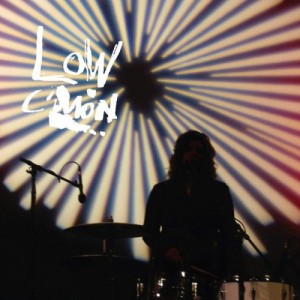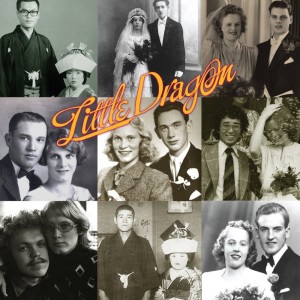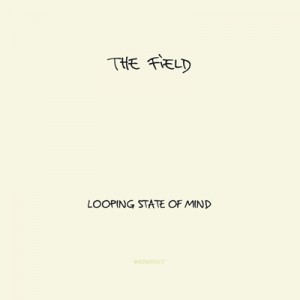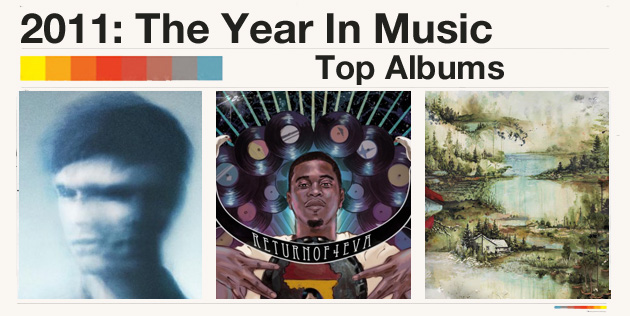Listen to One Thirty BPM’s top albums of 2011 in this Spotify playlist.

50.
Low
C’mon
[Sub Pop]
After 2007’s Drums & Guns gave him a chance to vent about Iraq, and last year’s second Retribution Gospel Choir album gave him a chance to rock out, Alan Sparhawk returned with Low this year delivering what they do best: devastating songs focused on, but not limited to, love. The beauty of C’mon is immediately evident from the twinkling opening of “Try To Sleep” and remains current throughout songs like “Especially Me” and “Nightingale.” But, at the same time, Low were not afraid to get a little more fierce with songs like “Witches” (about Sparhawk’s father) and the colossal eight-minutes of pure building in volume that is “Nothing But Heart.” The most affecting part of C’mon is the earnestness with which every song is delivered by Sparhawk and his partner Mimi Parker. When Sparhawk tells you that he’s “weary and stumbling from the desert heat” in “Done” you feel the burden (helped greatly by some atmospheric wailing guitar and booming drums), and when Parker lamentably intones about being lost and hopeless over a mournfully bobbing 6/8 rhythm in “Especially Me” you can’t help but relate.
C’mon is Low’s ninth album and by this point almost any band would be repeating themselves. This may be true thematically on C’mon, but with the emotional honesty that they do it lyrically, vocally and instrumentally, their albums will always be affecting.
– Rob Hakimian

49.
ASAP Rocky
LiveLoveA$AP
[RCA / Polo Grounds Music]
In case you didn’t hear, this kid A$AP Rocky got a bigger advance than Drake did. That’s right, what this drugged out Harlem kid brought to the table convinced some very powerful suits that he was worth more than everyone’s favorite singing Canadian mannequin. Those aware of the state of the charts may nervously ask, ‘why, exactly?’ Well, the label clearly sees the chance to invest in something “cool” with Rocky. It’s an odd thing: despite the changes in sound, one way or another, from Chuck D, to Dr. Dre, to 50 Cent (and even Eminem, on a bad day) all gained popularity through a ‘gangsta’ persona. What White America’s interest in this represents has been debated to no end, but the fact remains: people like a G. For the first time in hip hop history, “real shit” has almost no place in mainstream rap. Young Jeezy can hardly get his album released, and 50 Cent simply can’t. The closest thing is Rick Ross, marching about in his one man play. A$AP Rocky – and his label – believe the lost aspect is far from gone, simply misplaced. Above all, LiveLoveA$AP finds that vibe many have looked for ever since they found their way out of the Wu’s chambers: carried by a sensibility very much in the now, and those Clams Casino soundscapes, this is a New York gangsta (something else that’s been missing) for the now. We’ve been looking for this guy.
– Chase McMullen

48.
Tim Hecker
Ravedeath,1972
[Kranky]
I’m gonna be honest; I didn’t love this album when I first heard it. Not the way I loved An Imaginary Country and Harmony in Ultraviolet, anyway. Maybe that’s just because I’ve grown weary of the concept album, and while there’s not much of a discernible “plot” here, Ravedeath, 1972 — recorded in a church with an old pipe organ that was later digitally treated with help from Icelandic producer Ben Frost — is certainly an album that revolves round a concept, in this case the idea of musical detritus and “digital garbage.” But after putting aside Ravedeath for a while in order to let the surrounding critical hype and epistemological questions dissipate, I returned to it expecting adequacy and was surprised by its excellence. Ravedeath, 1972 does a lot more than it lets on; though it may initially seem monolithic and almost overwhelming, it turns out that Hecker’s subtlety (along with Frost’s experienced touch) can manifest itself in even the bleakest of conditions. And yes, this LP is bleak; who knew an MIT student prank could inspire such aural austerity? But what lies just beneath this album’s rocky, grayscale surface is a comforting assurance that music will survive long after the various media on which it’s stored have been disposed of or abandoned and forgotten in some record collector’s dusty “Miscellaneous” bin. And however intimidating this album might sound, such an assurance is always cause for celebration.
– Josh Becker

47.
Cymbals Eat Guitars
Lenses Alien
[Memphis Industries]
There exists a palate of tropes and signifiers in indie rock, as in any subgenre of pop music, that just aren’t going anywhere. And for good reason. Guns, girls, getting fucked up, and feeling painfully like a person each aren’t going anywhere, and it takes a rare voice to cast them in a lens so intensely listenable as Cymbals Eat Guitars does on Lenses Alien. Informed equally by the likes of Pavement and The Promise Ring, the record is an alarming tour of intimacy and squall, a sort of cognitive drama that hits hardest when rooted in scene, a gesture it implements with pleasant comfort. On “Plainclothes” our speaker relates a copkiller narrative with adolescent memory and replaces Eucharist with the kind of mushrooms that allow an alternative worship, and yet never does it feel too mighty a leap. Suburbia is a landscape often explored, but Cymbals Eat Guitars’ tri-state wasteland is affectingly original: brutally vapid and yet religiously significant, a stage for our most willfully youthful demons.
– FM Stringer

46.
Dum Dum Girls
Only In Dreams
[Sub Pop]
Distinguishing yourself these days is freaking tough. Everyone is culling from the same past, so when you have an uprising of twee-hards or 90s slackers or girl-group revivalists all cut from similar cloths, you start pointing out specifics that maybe aren’t that specific or perhaps just arbitrary. Granted, first records are one thing — you’re getting your bearings, everyone loves a fresh new thing even if it kinda sounds like that band you were into a few months back (trend piece!) — but in this the internet age, so come sophomore release it’s kill or be killed, stay inside your fuzzbox (sorry, Vivian Girls) or, y’know, grow.
All easier said than done, but on Only In Dreams, Dum Dum Girls did just that. It’s not that you had to worry about frontwoman Dee Dee’s songwriting capabilities, because you’d be hard pressed to find a tighter bunch of tracks that shimmer so lithely on a record with such dark undercurrents. The deftness with which Dee Dee tackles separation, anxiety, and death all running through her, and this record, is astounding: the deceptively light “Caught In One,” the stunningly simple sentiment of “Bedroom Eyes,” the solipsistic turn of “In My Head,” and that wail, that voice, on “Coming Down.” That all of this comes served with some of the most delightful and gorgeous melodies of the year — well, it’s really more than enough to make Dum Dum Girls stand out more than they already did.
– Jon Blistein

45.
Little Dragon
Ritual Union
[Peacefrog / EMI]
Little Dragon’s Ritual Union shows the band moving away from the 80s vibe of their previous release, Machine Dreams, and moving towards a sound that they can call their own. It’s a great mix of electronic, R&B, pop and jazz influences. The overall tone of the album would fit perfectly on a rainy day, but it’s not limited to just that. The tambourines and funky synth lines on “Little Man” can get everyone out on the dance floor. The atmosphere and steady rhythm on “Crystalfilm” is great for a late night drive.
The rhythm section is tight and the individual skills of Fredrik Wallin, Hakan Wirenstrand and Erik Bodin compliment each other well. And I have nothing but compliments for vocalist Yukimi Nagano. Her vocals intertwine beautifully with the music, winding through drum beats and bass lines. I’ve always loved that Nagano’s vocals flow with the music, rather than sitting on top and overpowering it. Ritual Union only furthers Little Dragon’s musical abilities and the range of their influence.
– Nicholas Preciado

44.
Beyonce
4
[Columbia]
For many people, 2011 will be remembered as the year that Beyonce made her first truly brilliant album. Though it has been damn near impossible to deny her talent as both a singer and a performer since she first gained stardom with Destiny’s Child, Beyonce as a songwriter always had room for improvement. Each of her three previous solo albums had genuine highlights to be sure, but 4 marked the first time where Beyonce had crafted an album that can and should be taken in as more than merely a collection of good songs. As an even greater testament to her success with 4, the only track on the album that sounds out of place, (“I Was Here”), is also the only one on which Beyonce is not listed as a co-writer. 4 is the album where arguably this generation’s most talented female pop-star threw caution to the wind and acknowledged that she had nothing left to prove. With this boldness came an influx of wide-ranging influences from psych-R&B (“1+1”), to Fela Kuti inspired afrobeat (“Countdown”), and everything in between. By diversifying her sound, Beyonce crafted her best and most personal work yet. 4 is as bereft of pandering as it is of filler and for a woman so close to the center of the cultural zeitgeist to have created such a work is worth applauding.
– Ricky Schweitzer

43.
Feist
Metals
[Cherrytree / Interscope]
After exploding into the mainstream with the apple certified “1,2,3” it wouldn’t have been surprising if Feist had capitalized on this success with an album full of catchy singles. But the thing is, Feist has been an established artist long before the Grammys and iPod owners had “discovered” her in 2007. Prior to this newfound exposure, Feist made albums that were understated, and beautiful. She’s always had the ability to craft a much larger sound out of her stripped down writing, with the mixing of her hushed vocals over chilling arrangements. The Reminder was really no different; accept a couple songs that were just so damn catchy it was impossible for people to resist. Metals sees her slip back into what she has always done: making spaciously beautiful music. But this time we get a mix of layered sounds that manage to creep in throughout the album. Six albums into her career, Feist shows us that she’s perfected what she’s good at, while also demonstrating some new tricks she has picked up along the way.
– Brent Koepp

42.
The Field
Looping State Of Mind
[Kompakt]
Back when we first met Axel Willner in 2007, he had just made From Here We Go Sublime, a masterstroke of minimal techno. On that album Willner made known his incredible talent for building and expanding upon simple sampled loops until the sound is grand and large, while still retaining the aspects that place it in the “minimal” category. The samples Willner chose made the songs sound so familiar, even to a person who had never so much as glimpsed at a Field record before. Next came 2009’s respectable but largely unassuming follow-up Yesterday and Today, which saw Willner expanding slightly farther out of the minimal bubble and even adding (gasp) vocals. Little fanfare was to be had for that record, and thus my expectations for Looping State Of Mind could be characterized as unsure, so I was not disappointed by what I heard. Though it proves not to be From Here We Go Sublime 2: From Here We Go Sublimer, it is a very much welcome return to the forms that made that first record so great. Its title is entirely apt. Willner makes a loop back to a focus on building, expanding, and screwing with loops, sometimes for over 10 minutes at a time, and including from time to time fragments of Y&T. The vocals on “Burned Out” don’t come as a shock, and the synth motif that comprises most of “Is This Power” feels like it picks up where Y&T left off. But the real shining moments of the record are those that recall the desolate, icy landscapes evoked by FHWGS such as the beginning chords of “It’s Up There,” or the beautiful, wintery, and stuttering “Then It’s White.” The album also lies between FHWGS and Y&T in its density. The tracks are long; you won’t find one shorter than seven minutes, but they’re just long enough that they don’t try the listener’s patience, and seem to work in such a way that the listener with the patience to sit through the back-to-back 10-minuters “Arpeggiated Love” and “Looping State of Mind” will be the listener to take away the most rewarding experience. However, this is one experience that is entirely worth making time for.
– Harrison Suits Baer

41.
Oneohtrix Point Never
Replica
[Mexican Summer]
The samples on Replica were scrounged from DVD collections of decades old TV advertisements. Compilations of thirty-second fragments strung together in an endless parade of cast off, dead and buried zeitgeist for people to relive over and over. The advertisement is designed to manipulate, in itself often feeding off a person’s sentimental attachment to childhood or to a specific emotion. It’s not a surprise people get sucked in. I won’t name names, but we have music like this too. Textures, melodies, and production techniques that recall a specific era for its own sake have become an institution of sorts and 2011 wasn’t exactly a break from the trend.
Oneohtrix Point Never isn’t a stranger to accusations of perpetrating the latter. His 2009 collection, Rifts, had little to offer beyond retro-futuristic synthscapes that wouldn’t have been out of place in a John Carpenter movie. But OPN’s third record thrives on self-awareness, seemingly asking the question, when does this aggrandizing of the past become unhealthy? Replica contrasts rich analog synth melodies and delicate piano with chopped up samples from vintage advertisements to create little self-contained universes in stuttering states of decay. The record beautifully captures the tragedy of nostalgia in a musical landscape often bent on chasing after the ideal of the past rather than building upon what it’s given us.
– Will Ryan


